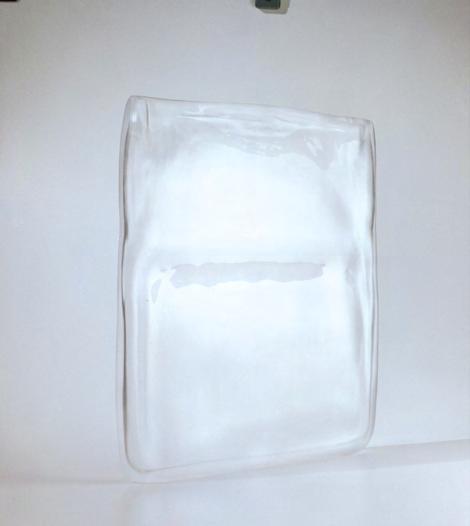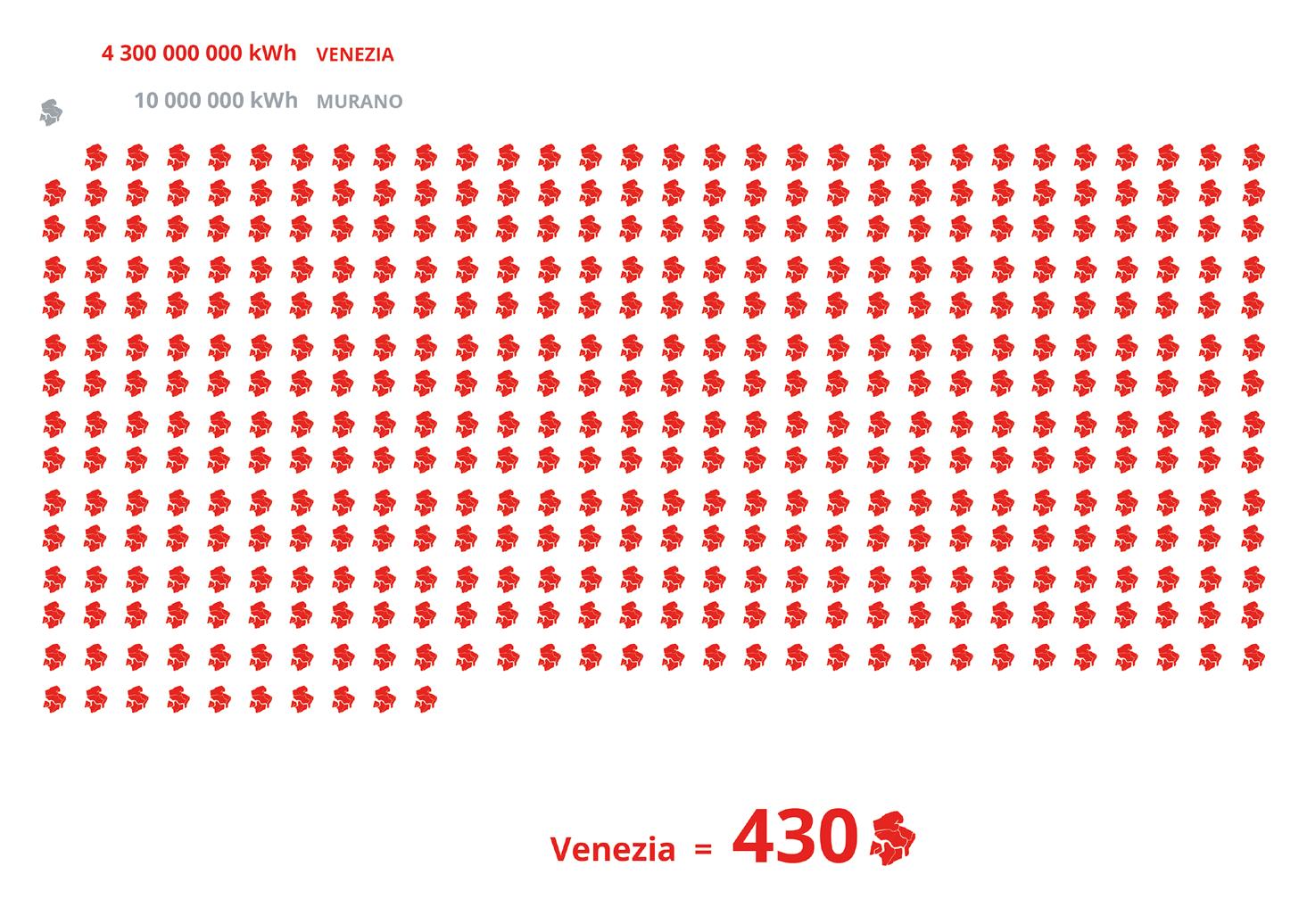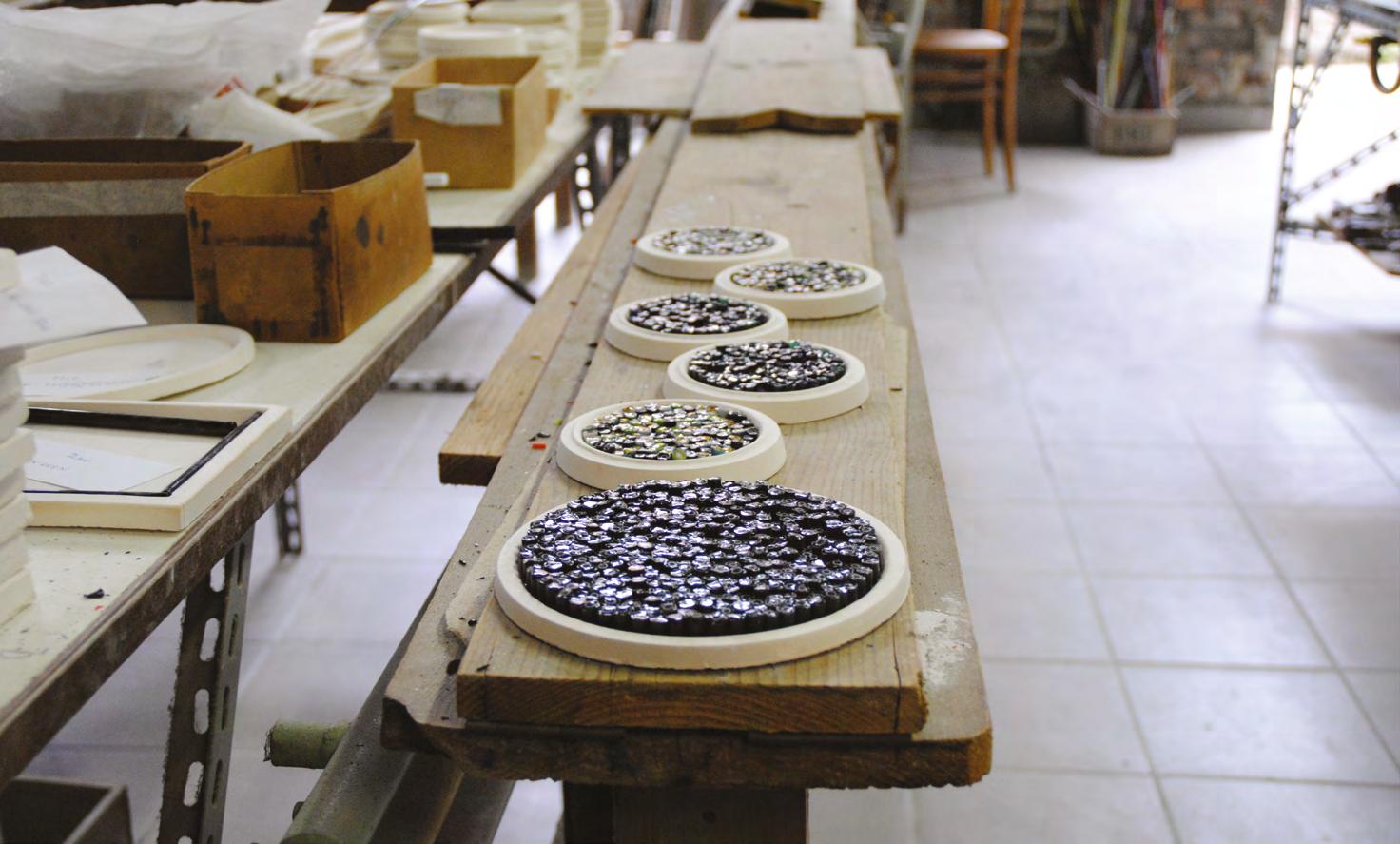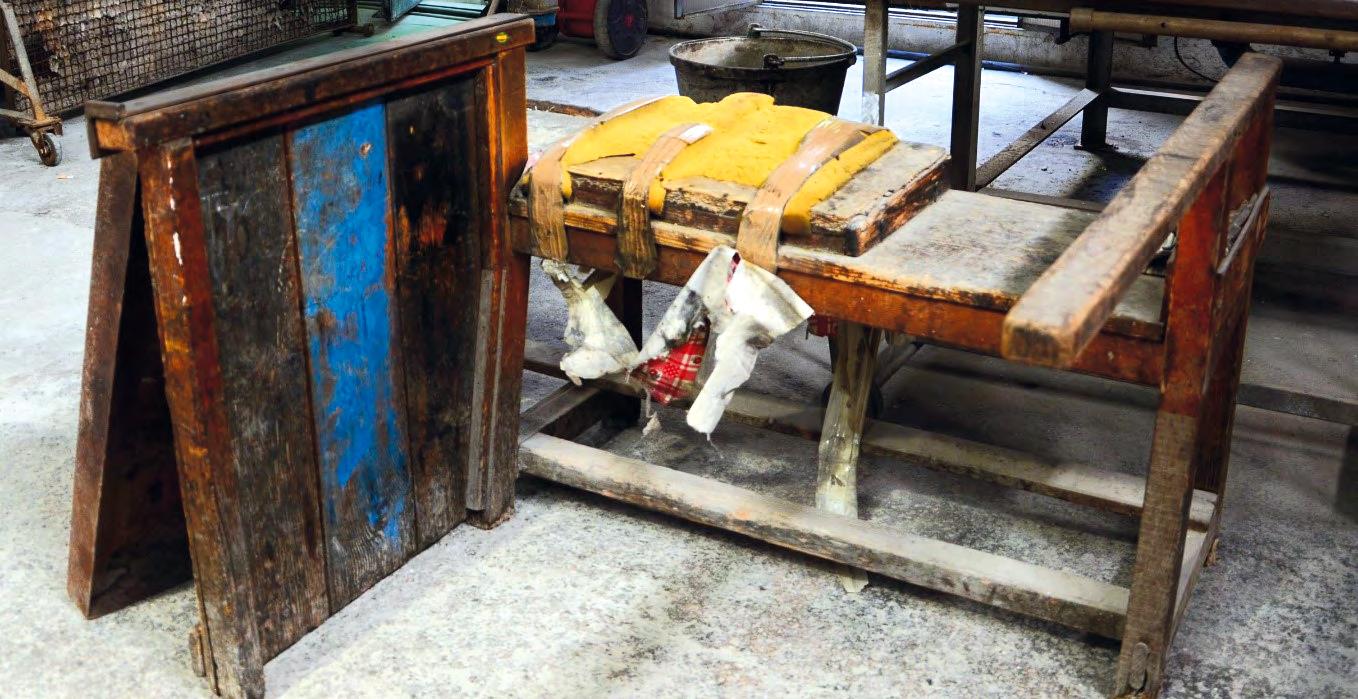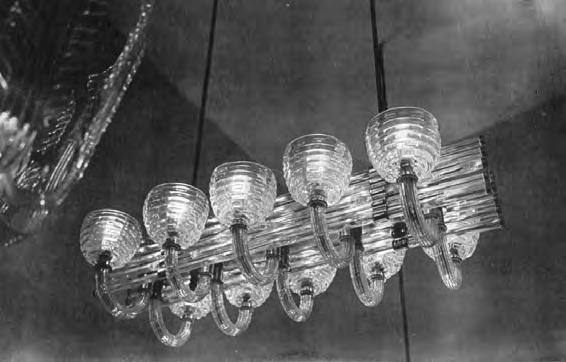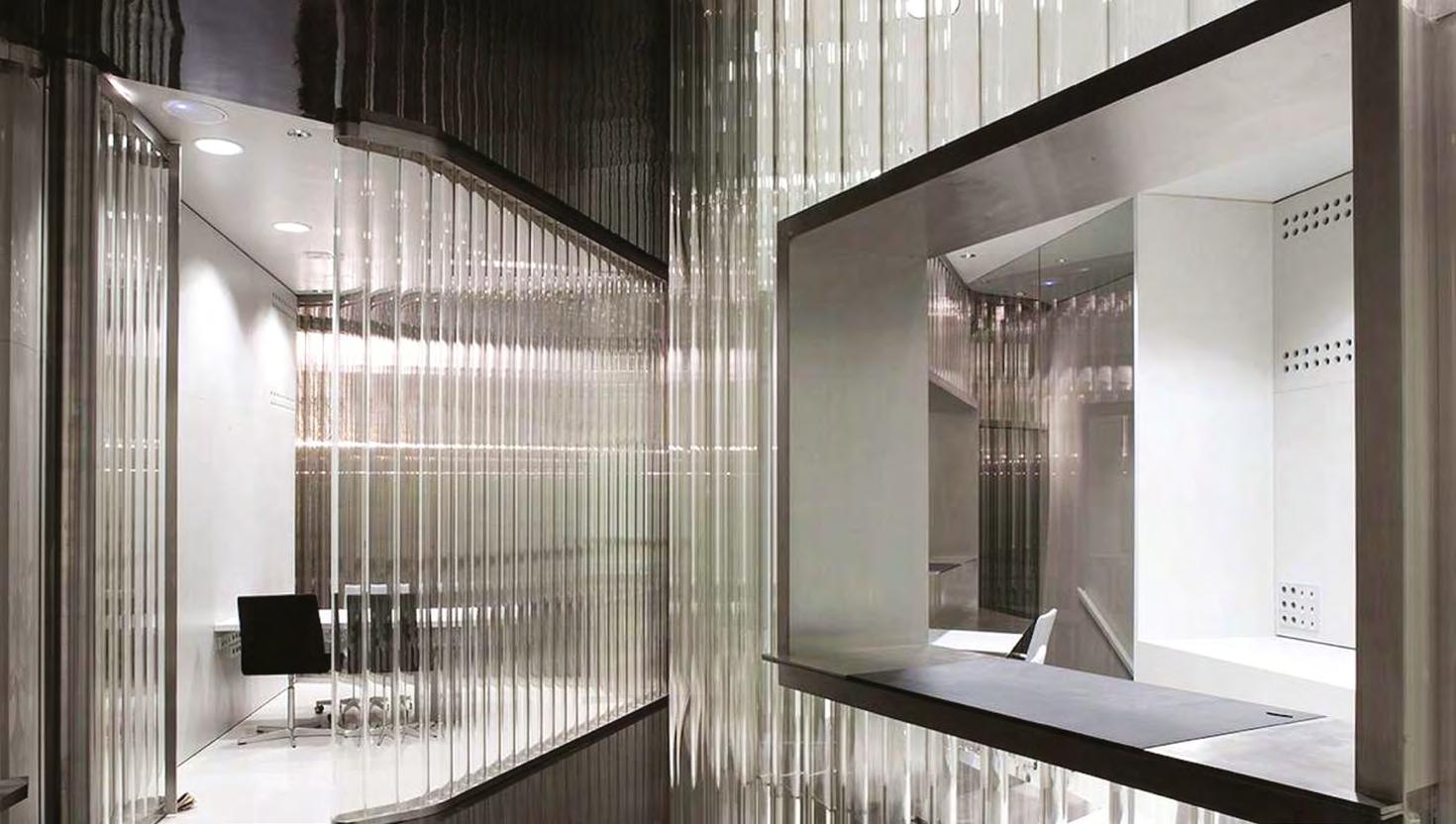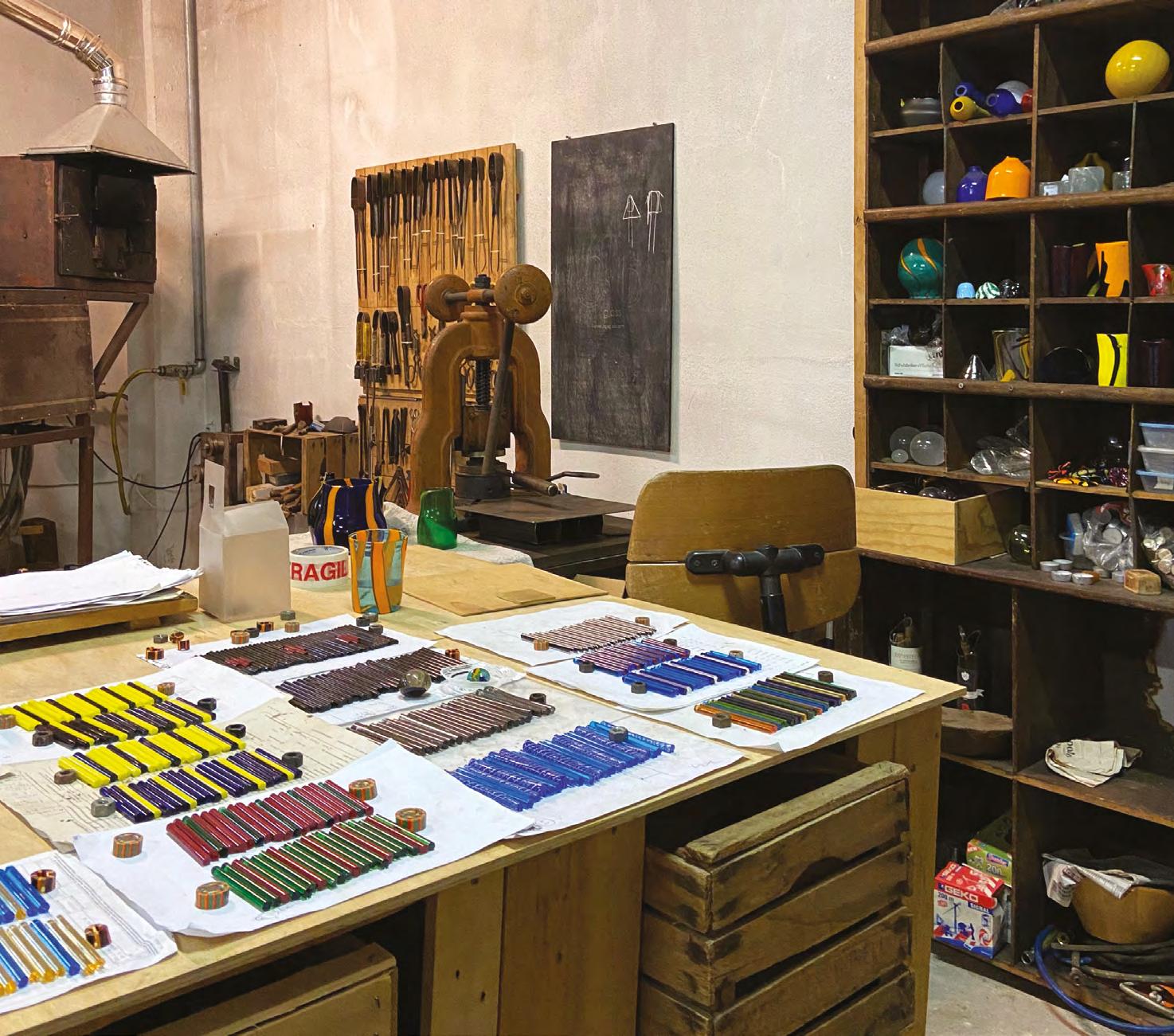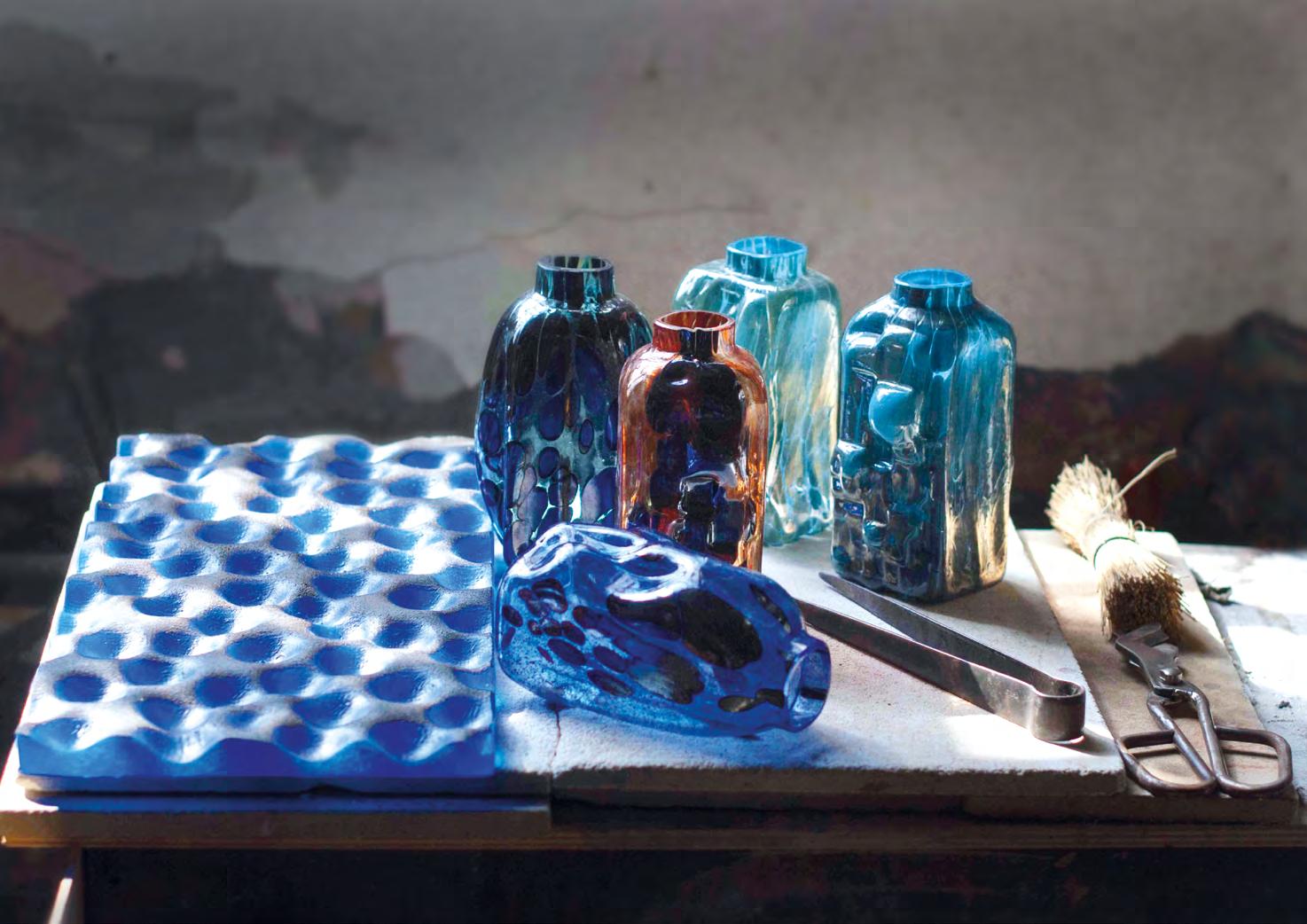
19 minute read
MURANO PIXEL. An experimental and shared research
MARIA ANTONIA BARUCCOA, ELTI CATTARUZZAB, MATTEO SILVERIOC
KEYWORDS: CIRCULAR ECONOMY, UPCYCLING, EXPERIMENT
The paper describes the motivation, approach and working methodology of a research project financed with POR FSE funds by the Veneto Region. The research involved two universities (Università Iuav di Venezia and Università Ca’ Foscari Venezia), three glassworks in Murano, two network partners (Anteferma Edizioni and WASP) dedicated to innovation and the dissemination of innovation, and three young researchers. A network of professional figures, production realities and interlocutors developed around the figures institutionally involved in the project. These collaborations arose from the desire to share knowledge, production skills and experimentation. Moreover, the research was not limited to Murano but opened up this territory to international debate. This paper proposes the Venice Lagoon as a case study to develop research dedicated to the recycling of materials towards an increasingly comprehensive and complex approach. This is a challenge. The short circuit between the vitality of artisan work and research activity must be triggered.
A Department of Architecture and Arts, Iuav University of Venice, Venice. B Department of Molecular Sciences and Nanosystems, Ca’ Foscari University of Venice, Venice. C Co-Founder rehub (Iuav Spinoff) Italy, Murano Venice.
Introduction
Murano and its glass, between art, craft and industry, are part of the lagoon ecosystem: economic weight, historical value, excellence at an international level, a cultural trait of a territory and more. A series of criticalities accumulated over time, before the health emergency and the current international crisis, have undermined the functioning of the dynamics that have characterized work in the furnace over the last hundred (and more) years, dynamics that today seem to be more than suspended, shattered.
Murano glass is a famous Venetian craft product that has long been the subject of study and research aimed at giving it new beauty, variety and value. For this reason, Venetian glass is a challenging topic and it is possible to devise a policy that uses digital technology to overcome the limitation of activities within local processes (Vettore, 2019).
The research addressed these critical issues and challenges by analyzing and planning the reuse of Murano glass waste. This was done starting from a description of the state of affairs and production processes characterizing Murano. In addition, the island’s strong craftsmanship vocation and the capacity for experimentation of the master glassmakers were emphasized.
The research1 made it possible to bring the challenge of the digital closer to the craft and artistic work of the Master Glassmakers. To do this, the digital was defined as much more than a computer or a machine: the digital component of the craftwork was interpreted as the grandiosity of connections made available to develop projects and studies in which experimentation prevails over realized design (Antoniol and Barucco, 2020). The research took the opportunity to experiment and work in the furnace, finding support from three master glassmakers, and dialoguing with Venetian figures and institutions. The research fellows worked in the furnaces of Murano and in the chemistry laboratory of Ca’ Foscari. The research fellows also built contacts with other industrial and industrious realities in the field of experimentation in order to test and prove the new recycling of Murano glass.
The greatest complexities in the development of research are due to the historical period of extreme complexity. These complexities are accentuated by the superficial perception of Murano and the art of glassmaking as realities focused on and immobilized in their own history and tradition. Nothing could be more false. The history and tradition of Murano glass describe first and foremost creativity and experimentation, collaboration and competition between masters, and glassworks striving for the new. To
1 Il progetto circolare del vetro artistico di Murano: come gli scarti divengono risorse per l’industria artigiana 4.0.
Codice Progetto 2122-0001-1463-2019. Programma Operativo Regionale Fondo Sociale Europeo 20142020 – Obiettivo generale “Investimenti in favore della crescita e l’Occupazione – Reg. 1304/2013 – Asse I
Occupabilità – “Le Strategie regionali per il sistema universitario – Innovazione e ricerca per un Veneto più competitivo” – Delibera della Giunta Regionale n. 1463 dell’8 ottobre 2019.
Fig. 01 Glass processing. M. Silverio, D. Frison
cope with the crisis, research has been imagined and developed as a meeting place for skills, inspirations and craftsmen. Research offered and still offers knowledge for experimentation, innovators and researchers.
Research asserts its role through interdisciplinarity2, the analysis of production processes and the proposal of new circular dynamics for the reuse of waste. Research is made up of many experiments, information and communications developed by very young researchers3. Through an analysis of the opportunities related to the complexity and particularity of the field of investigation, the research proposes a new articulation of the guiding principles of the circular economy, emphasizing the value of experimentation in extreme contexts in order to be able to draw useful generalizations for more widely shared progress.
Moreover, at a time of extreme economic and social hardship, when the Murano furnaces are dying out, practical and theoretical research, experimentation and study have combined in a frenzy that deserves to be highlighted. Some glass masters have opened their doors to researchers and experimented with glass processing and manipulation techniques that do not exclude digital fabrication and additive technologies. Research has probed
2 The scientific directors of the research are Maria Antonia Barucco (Associate Professor, Architectural
Technology ICAR/12) and Elti Cattaruzza (Full Professor, Experimental Physics FIS/01). 3 Paola Careno, Stefano Centenaro, Filippo De Benedetti.
new markets for Murano glass and imagined new declinations of the definition of Master Glassmaker and new life cycles for what is considered waste.
Research responds to the severe crisis with a discipline of work based on flexibility and by exploring an astonishing wealth of usually hidden knowledge and arts. The boundaries between disciplinary areas and sectors are overcome. The research investigates the dynamics of a production and a territory that are related to each other as an ecosystem. Unfortunately, today these dynamics are almost immobile. Murano glass is the result of ancient traditions that are still alive thanks to the work in the furnace, which is made up of attempts, challenges and experimentation shared by several craftsmen. This drives research and awareness that saving raw materials, recycling waste and making the supply chain more efficient are fundamental. Missing the opportunity to innovate, avoiding dialogue with multiple fields of study and denying the directions of Industry 4.0, stopping research as well as shutting down many (too many) furnaces means precluding Murano from the possibility of facing the developments of the 21st Century with quality.
Breakdowns
If inconstancy is the humus for the emergence of communities (Putnam, 1993), it is also the foundation of all innovation and invention. If a network of relationships connects people, skills and interests, if this network has an instrumental character, it can survive all kinds of disruptions because when one node or link is unraveled, others that are different or similar will take their place. The inconstancy of the network and its transformations over time are not a problem; on the contrary, they are the hallmark of a community, which in this way becomes antifragile (Taleb, 2013). The instrumental character, the goal of achieving something, keeps the network alive in its complexity even when its components are missing. And the something that is achieved by virtue of such a system of relationships benefits all those who make up the network and has a value that is greater than the sum of the values perceived by individuals because it is made up of the connections and stories woven from the vicissitudes of which inconstancy is made.
Murano glassmaking has an antifragile history that is not one of gradual growth but is made up of a series of ruptures and crises through which a community, an island of glass, builds its identity. Around the year 1000, glass was already being made in Venice with identifiable techniques and results; it was the growing complexities and fluctuating fortunes of the glass industry that gradually established its presence on an international level. The profound crisis following the plague of 1630 and the Bohemian glass boom are perhaps the most famous crises: Murano resurrected and affirmed its value by displaying new complexities and virtuosity in glassmaking. The postwar period also profoundly marked Murano: of that time we remember the
experiments conducted with architects and designers as well as the ancient techniques studied, tested and re-proposed to become a characteristic feature of the glassworks that are still internationally renowned today. Hybridities, exchanges and currents of study, work, information and experimentation are being severely tested even at the beginning of the 21st Century: surveys by the Promovetro Consortium report on the crisis, the reduction of employees and the fragmentation of large companies into small family businesses (Centro Studi Sintesi, 2015). It is not difficult to find a connection between these trends and the economic crisis of 2008, which caused the decrease in purchasing power of many customers (Centro Studi Sintesi, 2015). Added to this is the pandemic and insane island status that has imposed on Murano (and Venice as a whole, as on many other cities around the world) an absolute isolation to mitigate which the power of the internet can only offer some remedy and, in a few lucky cases, open some doors to future prospects.
Moreover, the excellence and particularity of the workmanship performed in Murano do not escape the evolution of workplace safety and pollution regulations: in 2001 the toxicity of siribites was recognised (ECHA, 2021a), in 2014 the use of diarsenic trioxide was banned, and in 2018 the use of cadmium was banned (ECHA, 2021b). Three constraints have led to the discontinuation of processes that characterize Murano glass: it is no longer possible to produce glass beads, it becomes more difficult to produce opaline glass, and it is no longer possible to reproduce the chromatic richness of warm-coloured glass and the uniqueness of the ruby-red color.
Despite all this or, more correctly, precisely because all this has happened and is happening, Murano designs and experiments to amaze again. The shift from industrial (capital-dominated) to digital (information-dominated) modes of production demands a radical change in the relationship between the production system and knowledge (Vettore, 2019). This transformation also involves (or overwhelms) small industries and workshops in Murano. Moreover, the aforementioned environmental constraints together with new socio-economic dynamics are pushing towards a renewal of the systemic structure of artistic glass production. But in a world rooted in tradition, it is not easy to make room for new and increasingly indispensable concepts, such as the emergence accounting method to assess the environmental sustainability of Murano furnaces in the production of colored glass (“Emergy” Accounting method) (Spagnolo et al., 2018).
The information and easiness in managing the flow of communication between distant places creates a series of short circuits and consequent wonderful sparks of experimental craftsmanship. Murano is connected with external glass industries (which until a few decades ago were only considered competitors), and promotes international events that attract operators from all over the world. An example of this is The Venice Glass Week, an international festival organized by Promovetro, Consorzio di tutela del Vetro
artistico di Murano, Fondazione Cini, Fondazione Musei Civici di Venezia and Istituto Veneto di Scienze Lettere ed Arti. Since 2017, The Venice Glass Week has brought new life and energy and offered pretexts for transgressing the practices of established production processes. At the first edition, a group of young designers promoted a “new technology education” (Silverio and Frison, 2017) during which six master glassmakers were joined by six designers with skills in 3D modeling and the use of digital fabrication tools. Three months of experimentation produced works, aroused the interest of many and won important awards.
The AUTONOMA 2020 award was won by the Touch-Me collection (Silverio+Bullo), which is the result of research aimed at subverting the perception of glass. The glass objects in this collection can be continuously transformed and manipulated. The glass used for Touch-Me is waste from other productions and the various glass parts are connected by a polymer matrix. They are fully reversible objects, designed under the banner of the circular economy.
Also ‘Vi – The divine chandelier’ by Maestro Fabio Fornasier is a work dedicated to the reuse of glass waste: he forged a bottle-green chandelier by reusing 180 Franciacorta wine bottles during a performance organized by the Lombardy Wine Consortium.
The prototypes realized during the POR FSE research were inspired by these examples. They are all realizations that try to combine tradition and innovation and that propose the reuse of glass scraps to develop new products, even for sectors other than those that are the normal reference for Murano art glass companies (Barucco et al., 2022). The continuous and mutual training of specialists is the main tool to develop these innovations, equally important is the trust between the people involved and the sharing of knowledge.


Fig. 02 Vero2. M. Silverio, rehub. Fig. 03 Touch me. M. Silverio, S. Bullo
Continuity
The second lives of what is generally regarded as waste can be categorized according to the quantity and type of waste materials as well as possible regeneration, valorisation, recycling or reuse. In line with this assumption, the Ellen MacArthur Foundation describes and subdivides materials into four categories: • old glories. Materials that are easily recoverable and have a good level of recyclability. These are materials that have already undergone recycling routes but often have the disadvantage of losing quality. Example: paper; • materials with high potential. They are available in large quantities but lack systematic solutions for their recycling. Example: polymers, recycling changes their quality and purity; • diamonds in the rough. Materials with great potential but with life cycles that have not yet been fully exploited. Example: by-products of manufacturing processes await technological innovations for their reuse; • future successes, such as materials with very long use cycles or biobased materials: these are materials that can improve productivity.
The research described in this paper makes its contribution to this organization by proposing a fifth category of materials: • case studies. Cycles and recycling that are exemplary but cannot handle large amounts of waste or that do not solve problems related to high pollution levels.
Murano glass is a challenging material, for which no one demands recycling, also because it is the output of ancient craftsmanship and linked to the creation of works of art of world-class excellence. Like Murano glass, other challenging materials exist and often have the merit of representing the antifragile character of the communities in which they are produced or used and/ or discarded. Marble dust from the Carrara quarries is being experimented with in the textile industry. Part of the surplus milk produced in Italy becomes cloth. Rice chaff from the Novara and Vercelli plains is used in construction with great success. This list of case studies does not break down large levels of pollution or massive amounts of waste. The value of all these experiments is not measured by quantities. Certainly they are man-hours, they are machines, they are research, they are enterprise, work and satisfaction, but above all they are examples. Examples of an inventiveness capable of demonstrating that everything can be rethought from a circular economy perspective.
It is often wrongly implied that there are exceptions to circular economy schemes. But a paradigm shift will only be possible if everyone is involved in the new and future dynamics of material circularity. To dispel any doubts, some research must be devoted to clearly recognisable challenges. The examples confront the history, art and tradition of emblematic contexts. They are materials that must be described because all products and processes must work together to meet the challenges of sustainability.
Translation
The research described attempts to bring together study and knowledge, research and art. On the one hand the tradition and culture of glassmaking, on the other an interpretation of a famous definition of circular economy. Blown glass, lume working and leaded glass are ancient processes and the language describing their practices, intentions and outcomes is also ancient. A very different language from that of scientific research. A very different language also from the communications and slogans that speak to the world about sustainability. This research work is also made up of patient translation of specialized languages and translation of the results of the work into useful communications for a wide audience.
The research measures quantitative, qualitative and descriptive variables to assess waste in art glass. The research highlights some aspects of the contingency in order to develop an environmental policy that is consistent with the international landscape and, at the same time, able to offer a new contribution and a different point of view. The research analyzed the production of three glassworks4 producing stained glass, beads and blown glass. Discards were collected and processing was surveyed for two months. Production activity standards were recorded in order to produce analyses and abstractions useful to produce data describing one year’s activity.
A first datum is the ratio of the quantity of waste glass in relation to the quantity of glass produced (glass useful to be put on sale): 50% of the glass that is processed is discarded. The glass masters had never considered this comparison and did not think of discarding so much glass. There are no periodic measurements of the scraps of Murano glass, but there are heaps of scraps, beautiful and colorful masses of material. This material has an initial cost when it is purchased from glass factories in the form of cotisso, rods or glass plates; it has a very high processing cost because it is subjected to complex transformations by highly specialized hands; it has a considerable disposal cost because it is practically impossible to divide the waste by color.
Thanks to the available data and to the count of the glassworks in Murano, the quantities and types of waste collected have been multiplied and generalized. Each year Murano produces 392 cubic meters of waste glass in various forms: glass drops, bites of rods, broken beads, portions of plates, rolled glass, rollers, glass powder, and generic blown glass processing scraps. A useful measure to understand the total volume of waste glass is its translation into a typical Murano product: 392 cubic meters of glass can allow the creation of 31,250,000 glass goblets. Equally effective is measuring the work required to transport the waste glass. Murano is connected to the mainland only by
4 Vetrate Artistiche Murano (master glassmaker: Stefano Bullo), Costantini Glassbeads (master glassmaker: Alessandro Moretti), Nicola Moretti Snc (master glassmakers: Alberto Moretti and Nicola
Moretti).
boats: 392 cubic meters of glass must be moved from Murano to the landfill with 91 fully loaded 11-ton boats.
A range of possible uses for waste glass is identified through the organization of a list of case studies and experiments. A product or prototype can only be included in this list if it enhances the value of waste glass: it must characterize the final product, it must be qualitatively appreciable and it must be descriptive of the product itself. This requirement stems from the desire to valorise Murano glass waste. Some scraps, with their particular colors and shapes, tell of complex and unique workmanship. Other scraps are unique because they are the result of processing that is no longer done (and probably never will be done again): this is the case of the small beads of conteria that do not have a hole in them, that cannot be sold as pearls, and that are discarded and awaiting new uses, and are now closed in sacks and crates and in storage.
Murano glass scraps are very characteristic, they are the result of workmanship and craftsmanship, they contain a small part of a great story. In an era destined to build a future by virtue of the circular economy, these scraps can take part in a history made of prototypes and, perhaps in the near future, even new products of refined quality.
Enhancement
The research, following the path described, becomes a place for the development of a community dedicated to innovation, invention, and making and remaking with the cycles and recycling of art glass. Not only that, this research work is ‘resonant’ (Antoniol and Barucco, 2020): it has increased the intensity and quality of the relationships and exchanges between the subjects involved.
In order not to miss the confrontation with the material culture of Murano, the team of researchers worked in the glassworks as apprentice craftsmen. The glassmakers’ knowledge was hybridized with theoretical study, data analysis and chemical, mechanical and physical analyses carried out in the laboratories of the Iuav and Ca’ Foscari universities.
Among the innovations with which research has been confronted, one in particular is today fulfilling its most flattering promises. VERO2 is a process for manipulating Murano glass waste developed by Matteo Silverio. The waste becomes new raw material: a malleable paste that can be cold extruded using a fluid-dense 3D printer. With this process it is possible to produce new objects that, after a brief passage in the oven (at a temperature of around 700°C), sinter and lose the non-glassy part of the initial compound. The end result is 100% Murano glass.
This new technique for manipulating glass does not aim to replace the work of the master craftsman but seeks to enrich it with new features, first and foremost the reuse of waste. 3D printing also makes it possible to create objects with complex geometries, which are impossible to achieve
with traditional glass making techniques. For example, with this process, it is possible to create decorations that can be applied to the artifacts of master glassmakers, because they are made of the same raw material. VERO2 is therefore not only a new way of producing objects with a view to the circular economy, but also and above all a new tool at the disposal of Murano’s master glassmakers.
VERO2 started out as an experimental process and is now the knowhow behind rehub, the innovative start-up founded by Silverio that recently became an IUAV spin-off. After a year of research to optimize the process, a printer was designed and built with an ad hoc extruder: a patent application was filed for these inventions in May 2022. The extrudable glass paste, on the other hand, is covered by trade secrets.
Research, experimentation, dialogue between different skills and in-depth knowledge of the material once again prove to be a bridge between the past and the future (www.rehubstudio.com), a tool to make the art of glassmaking astonishing, once again and even more so than before.
References
Antoniol, E., Barucco, M. A. (2020). Tecnologia risonante. In Barucco, M. A., Bulegato, F., Vaccari, A., Remanufacturing Italy. L’Italia nell’epoca della postproduzione. Milano: Mimesis, pp. Xx-yy. Barucco, M. A., Cattaruzza, E., Careno, P., Centenaro, S., De Benedetti, F. (2022). Murano Pixel. Economia circolare per gli scarti del vetro artistico. Conegliano: Anteferma. Centro Studi Sintesi (2015). Murano: un’economia fragile? I numeri, le problematiche, le prospettive (online). In https://www. dl.camcom.it/script.aspx?PRISMABIN=1&objectid=c961081f6b594fcd85ae11445acbf6d5 (last accessed August 2022). ECHA (2021a). Substance Infocard: Cadmium Sulphide (online). In https://echa.europa.eu/it/substance-information/-/substanceinfo/100.013.771 (last accessed August 2022) ECHA (2021b). Substance Infocard: Diarsenic Trioxide (online). In https://echa.europa.eu/it/substance-information/-/substanceinfo/100.014.075 (last accessed August 2022) Putnam, D. R. (1993). Making Democracy Work: Civic Traditions in Modern Italy. Princeton: Princeton University Press. Silverio, M., Frison, D. (2017). Glass Matters. Catalogo 2017. Conegliano: Incipit Editore. Spagnolo, S., Gonella, F., Viglia, S., Ulgiati, S. (2018). Venice artistic glass: Linking art, chemistry and environment – A comprehensive emergy analysis. Journal of Cleaner Production, 171, pp. 1638-1649. Taleb, N. N. (2013). Antifragile. Prosperare nel disordine. Milano: Il Saggiatore. Vettore, E. (ed.) (2019). Ariffaraffa. Venezia, quel che resta del Centro storico e del suo Artigianato. Venezia: La Toletta.

